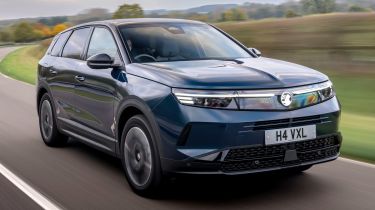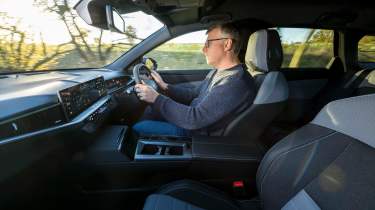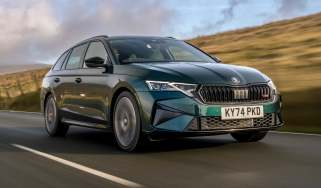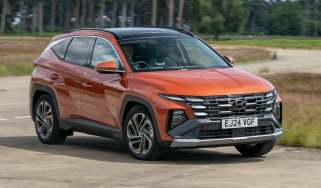New Vauxhall Grandland Hybrid 2024 review: SUV has its strengths but is far from perfect
The new Vauxhall Grandland is a big step forward, but still lags behind many of its hybrid SUV rivals

Verdict
The Vauxhall Grandland is a big step forward from the previous-generation car, and there are obvious strengths in size, front and rear space, specification, efficiency and value in particular, while the styling is also a step up. But the hard work the brand is doing to make its EV more price comparable makes the electric car a better bet than the hybrid, and in particular the powertrain isn’t refined, responsive or powerful enough to compete with some high-quality competition.
Since the demise of the Vauxhall Insignia, the Grandland has secured its position as the Brit brand’s flagship car, and the latest generation has solidified that by stepping up in size terms.
As well as its status at the top of the Vauxhall tree, that growth in dimensions creates space for a second mid-sized SUV, with the resurrected Frontera nameplate imminently slotting in beneath it, using the same electric and hybrid powertrain options. The Grandland is 173mm longer, 49mm wider and 36mm taller than before, and certainly looks like a bigger and more imposing car than its predecessor.
Though the Grandland Electric is the car Vauxhall is most excited about, it has EV targets to hit like all manufacturers, and although we won’t be getting the plug-in model sold in mainland Europe, the full hybrid version will be the one that appeals to drivers not wanting to look at electrification just yet.
More reviews
Car group tests
- Hyundai Tucson vs Ford Kuga vs Vauxhall Grandland: which is the ultimate hybrid family SUV?
- Ford Kuga vs Vauxhall Grandland: a mid-size SUV skirmish
- Vauxhall Grandland vs Kia Sportage 2023: twin test review
- Vauxhall Grandland vs Skoda Karoq vs Nissan Qashqai: 2022 group test review
In-depth reviews
Road tests
Used car tests
It’s a regular hybrid – a combination of petrol engine, small battery and electric motor. In this case a small engine; a 134bhp 1.2-litre three-cylinder, with a little 28bhp electric motor that uses a 48-volt battery to power the car, engine-free, for short periods.
It’s the same set-up as the Vauxhall’s Peugeot 3008 cousin – and it’s not the finest part of the Grandland’s package. The clue is in the numbers. Though the 1,600kg kerb weight isn't particularly excessive, and over half a tonne lighter than the electric Grandland, 134bhp isn’t really enough, and a lacklustre 10.2-second 0-62mph time translates to a feeling of lethargic progress when accelerating.
It’s not helped by the delay between hitting the accelerator and anything happening - a noticeable gap before the car jumps, or at least shuffles, into action. It’s also frustrating that the dash display doesn’t give a lot of information about when the electric motor has kicked in, and there’s no EV button, so the self-satisfied feeling of running with the petrol engine off at low speed is diminished. Some hybrid cars show how hard you can prod the throttle without waking the engine, but there’s none of that here. The car is just left to decide between the modes. The trade-off is strong economy; with official figures of up to 51.4mpg, it’s amongst the best in its class.
The Grandland isn’t the comfiest car, either. The ride quality lacks the kind of suppleness needed for British roads, with an annoying habit of jiggling over road ripples. Interestingly, our experience of the electric version is that it’s less afflicted than the hybrid.
On the plus side, the steering is nicely weighted for both high-speed and urban manoeuvring, while body roll seems well under control for a mid-sized SUV.
Vauxhall interiors have certainly come on in recent years, and the Grandland has a large array of good-looking and feeling materials across the cabin, with fabric, gloss, grey and black plastics, soft-touch leather and, lower down, harder plastics. It comes together well enough, and there’s a decent amount of stowage across the centre console. Adjustable cupholders and a sliding cover for the wireless charging pad, as well as big front door bins, are all welcome.
The glove box is pretty small though, and the drive selector switches in the middle of the cabin are the obvious place that Peugeot switchgear has been carried over.
Vauxhall has continued its good work with ergonomic seating for a comfortable long-distance experience, and the Grandland has, for the first time, headrests that move forward and backwards, as well as up and down. It’s a shame they're not softer.
The big 16-inch touchscreen is slick to operate, and works in conjunction with physical buttons to make adjusting the climate settings easier to do on the move.
Rear-seat passengers are the ones that will really appreciate the Grandland’s growth, though. As well as being positioned higher, stadium seating-style, they will find plenty of space, especially legroom, although the larger dimensions don’t translate to a big boot. Width-wise it’s good and there’s a decent under-floor area, as well as an array of tie-down points, hooks and pockets, but the 550 litres is behind the Kia Sportage and Hyundai Tucson.
Where the Grandland beats those cars is price. With the mid-spec, well-kitted-out GS costing less than any of the Sportage, Tucson or Nissan’s Qashqai, it makes a compelling case on price, although the hybrid versions of all those are significantly more powerful than the Vauxhall. The GS gets a rear-view camera, Intelli-Lux HD headlights with over 50,000 pixels, the 16-inch colour touchscreen, heated steering wheel and front seats, black roof and dark-tinted rear windows among other things, making it the smart choice in the range. The entry Design is missing a few important bits of equipment, given it’s less than £2,000 below the GS, and the top-spec Ultimate, while only another £1,750 further up, is populated by the kind of kit that is nice to have, but not essential.
But then there’s the small matter of the electric Grandland. A price chop to get Design and GS models below the £40,000 VED threshold has seen the Grandland EV drop well within range of the hybrid, only £1,750 more to buy and with experts predicting the EV will hold its value better. Given it’s also significantly more powerful at 210bhp and, if you can charge at home, the running costs could save up to £100 a month, it’s a compelling case. Especially given the hybrid isn’t a sparkling example of that powertrain technology.
| Model: | Vauxhall Grandland Hybrid GS |
| Price: | £36,385 |
| Powertrain: | 1.2-litre three-cylinder turbo petrol hybrid |
| Power/torque: | 134bhp/230Nm |
| Transmission: | Six-speed automatic, front-wheel drive |
| 0-62mph: | 10.2 seconds |
| Top speed: | 126mph |
| Economy/CO2: | 51.4mpg/124g/km |
| Size (L/W/H): | 4,650/1,905/1,657mm |
| On sale: | Now |










